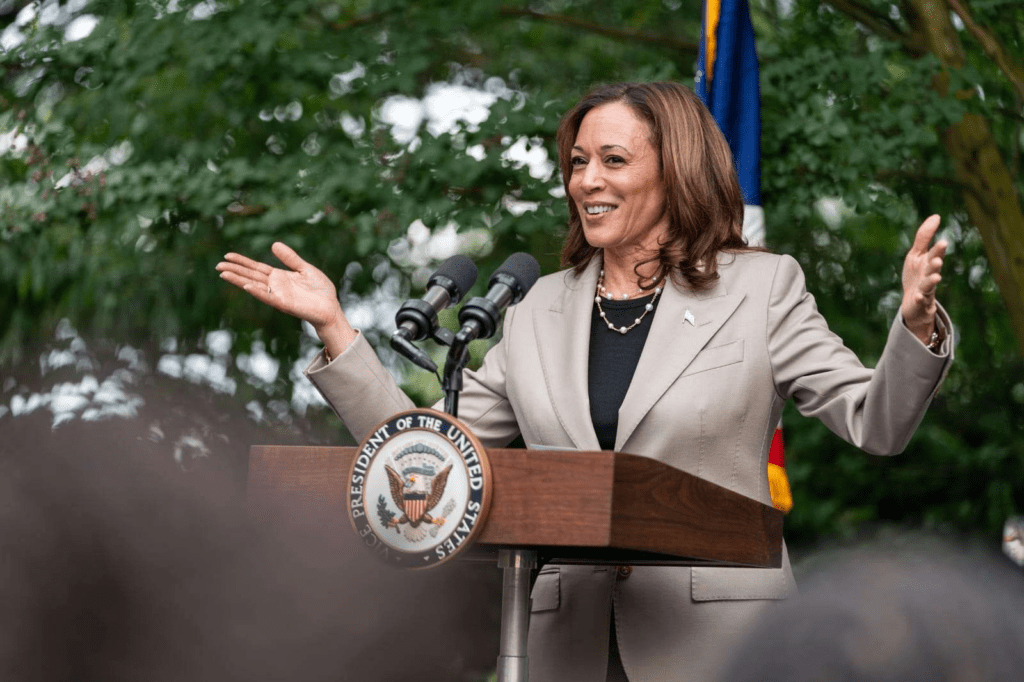The 2024 presidential race between Kamala Harris and Donald Trump represents more than just a political contest; it’s a referendum on America’s approach to one of the most pressing issues of our time: environmental policy. As climate change accelerates and ecological concerns mount, the stark contrast between these candidates’ visions for America’s environmental future has never been more consequential.
Kamala Harris: Champion of a Green Revolution
Kamala Harris has emerged as a torchbearer for comprehensive environmental reform, positioning herself as the candidate who will lead America into a sustainable future. Her environmental platform is both ambitious and far-reaching, encompassing everything from renewable energy initiatives to environmental justice reforms.
At the heart of Harris’s environmental agenda is a commitment to rejoin the Paris Climate Agreement. This move would signal a dramatic shift in U.S. foreign policy, realigning America with global efforts to combat climate change. Harris argues that by recommitting to this international accord, the U.S. can regain its leadership role in the fight against global warming and leverage its influence to encourage other nations to boost their own climate commitments.
The cornerstone of Harris’s domestic environmental policy is her support for the Green New Deal. This sweeping proposal aims to tackle climate change and economic inequality simultaneously through a massive overhaul of the U.S. economy. The plan calls for transitioning to 100% renewable energy within a decade, upgrading all existing buildings for energy efficiency, and investing in clean public transportation infrastructure. Critics argue that the plan is too costly and ambitious, but Harris contends that the long-term benefits to both the environment and the economy far outweigh the initial investment.
One of Harris’s more controversial proposals is the implementation of a carbon tax. This market-based approach to reducing greenhouse gas emissions would put a price on carbon pollution, incentivizing companies to reduce their carbon footprint and invest in cleaner technologies. While some economists praise the idea as an efficient way to drive down emissions, opponents argue it could lead to higher consumer prices and job losses in carbon-intensive industries.
Harris has also made environmental justice a key component of her platform, recognizing that low-income communities and communities of color often bear the brunt of environmental degradation. Her plan includes measures to address this disparity, such as targeting clean-up efforts in these communities and ensuring they have a voice in environmental decision-making processes.
Donald Trump: Deregulation and Fossil Fuel Advocacy
In stark contrast to Harris’s green agenda, Donald Trump’s environmental approach centers on deregulation and the promotion of fossil fuels. Trump’s philosophy is rooted in the belief that environmental regulations hinder economic growth and job creation, particularly in industries like coal mining and oil drilling.
During his previous term, Trump rolled back over 100 environmental rules and regulations, including Obama-era policies designed to combat climate change. He argues that these rollbacks have unleashed American energy production and boosted the economy. However, environmental groups contend that these actions have set back U.S. efforts to reduce greenhouse gas emissions by years, if not decades.
One of Trump’s most controversial environmental decisions was withdrawing the United States from the Paris Climate Agreement. He argued that the accord placed an unfair burden on the U.S. economy while allowing other major polluters like China to continue increasing their emissions. This move was widely criticized by environmental activists and world leaders, who saw it as America abdicating its global leadership role in the fight against climate change.
Trump’s energy policy, which he dubs “energy dominance,” heavily favors fossil fuels. He has opened up previously protected federal lands for oil and gas drilling, including parts of the Arctic National Wildlife Refuge. Trump argues that these measures ensure American energy independence and create jobs, but environmentalists warn of the long-term ecological damage and the need to transition to renewable energy sources.
The Ecological Impact: A Tale of Two Futures
The environmental policies proposed by Harris and Trump paint two vastly different pictures of America’s ecological future. Harris’s plans, if implemented, could significantly reduce the United States’ carbon footprint. Her emphasis on renewable energy and energy efficiency could accelerate the country’s transition away from fossil fuels, potentially putting the U.S. on track to meet or exceed its Paris Agreement commitments.
Moreover, Harris’s focus on conservation and increased funding for protected areas could help preserve biodiversity and protect endangered species. By expanding protected areas and enforcing stricter conservation laws, her policies aim to safeguard America’s natural heritage for future generations.
On the other hand, Trump’s policies could have far-reaching negative impacts on the environment. His promotion of fossil fuels and rollback of emissions regulations could lead to increased greenhouse gas emissions, potentially accelerating global warming. The opening of protected lands for resource extraction poses risks to biodiversity and could lead to habitat destruction for numerous species.
Trump’s deregulatory approach also raises concerns about air and water quality. The relaxation of pollution controls could lead to increased health risks, particularly in communities near industrial facilities. Environmental justice advocates warn that these impacts would likely be felt most acutely in low-income areas and communities of color.
The Elon Musk Factor: A Complicated Relationship

Intriguingly, the environmental debate surrounding this election has been further complicated by the involvement of Elon Musk, the enigmatic CEO of Tesla and SpaceX. Musk, widely recognized as a pioneer in sustainable technology, has had a complex and at times contradictory relationship with Donald Trump.
Musk’s companies, particularly Tesla, have been at the forefront of the push for sustainable transportation and energy. Tesla’s electric vehicles have played a significant role in popularizing EVs and reducing carbon emissions from the transportation sector. Similarly, Tesla’s solar energy and battery storage solutions have contributed to the growth of renewable energy adoption.
However, Musk’s interactions with Trump have raised eyebrows among environmental advocates. Early in Trump’s presidency, Musk served on several advisory councils, including the Manufacturing Jobs Initiative and the Strategic and Policy Forum. Musk argued that his presence on these councils gave him an opportunity to advocate for sustainable policies from within the administration.
This relationship became strained when Trump announced the U.S. withdrawal from the Paris Agreement. Musk, who had publicly urged Trump to remain in the accord, resigned from the advisory councils in protest. This move was widely praised by environmental groups, who saw it as Musk taking a principled stand against Trump’s climate policies.
Yet, Musk’s willingness to engage with the Trump administration in the first place highlights the complex interplay between business interests and environmental advocacy in American politics. While Musk has been a vocal proponent of action on climate change, his pragmatic approach to working with Trump suggests a recognition of the need to operate within existing political structures to advance his goals.
The Global Context: America’s Role in International Climate Efforts
The outcome of the Harris-Trump election will have ramifications far beyond America’s borders. As one of the world’s largest economies and greenhouse gas emitters, U.S. environmental policy has a significant impact on global efforts to combat climate change.
Harris’s pledge to rejoin the Paris Agreement and take aggressive action on climate change could reinvigorate international climate efforts. It could encourage other nations to strengthen their own climate commitments and accelerate the global transition to clean energy. Moreover, Harris’s proposed investments in green technology could spur innovation and drive down the costs of renewable energy worldwide. Conversely, another Trump term could further undermine global climate cooperation. His skepticism towards international agreements and promotion of fossil fuels could embolden other nations to backtrack on their climate commitments. This could potentially unravel the fragile consensus built around the Paris Agreement and set back global efforts to limit temperature rise.
The Economic Dimension: Green Growth vs. Traditional Industries
Both Harris and Trump have framed their environmental policies in economic terms, but with radically different visions. Harris argues that investing in clean energy and green infrastructure will create millions of well-paying jobs and position the U.S. as a leader in the industries of the future. She points to the rapid growth of the solar and wind energy sectors as evidence that environmental protection and economic growth can go hand in hand.
Trump, on the other hand, contends that environmental regulations stifle economic growth and cost jobs, particularly in traditional industries like coal mining and manufacturing. He argues that his deregulatory approach has unleashed American energy production and boosted the economy.
Economists are divided on these competing visions. Some argue that the transition to a green economy is inevitable and that countries that lead this transition will reap enormous economic benefits. Others warn of the short-term economic disruption that could result from rapidly phasing out fossil fuels and caution against moving too quickly.
The Role of Technology and Innovation

Both candidates acknowledge the importance of technology and innovation in addressing environmental challenges, but with different emphases. Harris sees government investment in clean energy research and development as crucial to driving innovation and bringing down the costs of renewable technologies. She has proposed increasing funding for agencies like the Department of Energy’s ARPA-E program, which focuses on high-risk, high-reward energy technologies.
Trump, while less focused on clean energy specifically, has emphasized the importance of American technological leadership more broadly. His administration has supported research into areas like advanced nuclear power and carbon capture and storage, arguing that these technologies could provide clean energy while preserving jobs in traditional energy sectors.
The debate over environmental policy in this election cycle reflects broader questions about America’s future: How can the country balance economic growth with environmental protection? What role should the government play in driving the transition to clean energy? And how can the U.S. best use its influence to address global environmental challenges?
As voters head to the polls, they will be choosing between two radically different visions for America’s environmental future. The stakes could not be higher. The policies implemented by the next president will shape not just the health of America’s ecosystems, but the trajectory of global efforts to combat climate change and build a sustainable future.
In this pivotal moment, the choice between Kamala Harris and Donald Trump represents more than just a political decision. It’s a choice about the kind of world we want to leave for future generations. As climate scientists warn of the rapidly closing window to avoid the worst impacts of climate change, the outcome of this election could well determine whether the United States leads the charge towards a sustainable future or remains tethered to the energy systems of the past.
Related Content
- OpenAI’s Initiatives to Safeguard Elections: Advanced Tools Against Misinformation
- Quantum Computing: The Next Frontier in Technology and Innovation
- Harnessing the Power of AI in Digital Marketing: Latest Trends and Innovations
- Breakthrough in Bioplastics: Barley and Sugar Beet Offer Hope for a Plastic-Free Future
- Navigating the Future: A Look at Growth Potential and Sustainability in Key Stocks
- Crypto and Compliance: What Investors Need to Know
- AI and Job Automation: What Roles Will Disappear?
- The Future of Renewable Energy: Innovations and Challenges
- Denmark to Implement World’s First Carbon Tax on Gassy Cows and Pigs
- The Latest Breakthroughs in AI: What You Need to Know in 2024
- The Role of Media in Shaping Public Opinion: Challenges and Responsibilities
- How Kamala Harris and Donald Trump compare on climate change » Yale Climate
- Analysis: Harris gets a dream start, but the task ahead is monumental | CNN Politics
- How Kamala Harris’ foreign policy would differ from Donald Trump’s in a 2024 showdown
- As Harris clinches the nomination, Trump’s team readies a new attack plan | The Guardian
- Trump wants to take US backwards, says Kamala Harris in campaign address
- How polls rate Kamala Harris’s chances against Trump – France24



